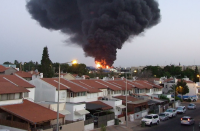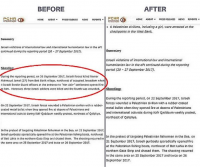
Links
Sheba Medical Centre
Melanie Phillips
Shariah Finance Watch
Australian Islamist Monitor - MultiFaith
West Australian Friends of Israel
Why Israel is at war
Lozowick Blog
NeoZionoid The NeoZionoiZeoN blog
Blank pages of the age
Silent Runnings
Jewish Issues watchdog
Discover more about Israel advocacy
Zionists the creation of Israel
Dissecting the Left
Paula says
Perspectives on Israel - Zionists
Zionism & Israel Information Center
Zionism educational seminars
Christian dhimmitude
Forum on Mideast
Israel Blog - documents terror war against Israelis
Zionism on the web
RECOMMENDED: newsback News discussion community
RSS Feed software from CarP
International law, Arab-Israeli conflict
Think-Israel
The Big Lies
Shmloozing with terrorists
IDF ON YOUTUBE
Israel's contributions to the world
MEMRI
Mark Durie Blog
The latest good news from Israel...new inventions, cures, advances.
support defenders of Israel
The Gaza War 2014
The 2014 Gaza Conflict Factual and Legal Aspects
To get maximum benefit from the ICJS website Register now. Select the topics which interest you.
Good Move on the Golan Heights
 President Trump holds a proclamation recognizing Israel’s sovereignty over the Golan Heights, at the White House in Washington, D.C., March 25, 2019. (Carlos Barria/Reuters) Now that the U.S. has recognized that they belong to Israel, Syria’s leadership after Assad would not be asked to humiliate itself by ceding the territory.
President Trump holds a proclamation recognizing Israel’s sovereignty over the Golan Heights, at the White House in Washington, D.C., March 25, 2019. (Carlos Barria/Reuters) Now that the U.S. has recognized that they belong to Israel, Syria’s leadership after Assad would not be asked to humiliate itself by ceding the territory.
President Trump didn’t spell it out, but there’s a sound rationale for America’s recognizing the Golan Heights as a permanent part of Israel.
Syria has been an unhappy political experiment. It never secured for its multiethnic population freedom, prosperity, or domestic tranquility. Aided by Iran and Russia, the Bashar al-Assad regime has just won a long civil war through mass murder of its own civilians (including by use of prohibited chemical weapons) and by imposing on other countries millions of desperate, impoverished refugees. Under the circumstances, there is no compelling reason for local or world powers to remain committed to reassembling Syria as it existed before the civil war.
Syria’s borders have spawned resentment and belligerence among the country’s leaders, who have never respected the lines. They have continually used their military forces or terrorist proxies to violate the sovereignty of Lebanon, Turkey, Iraq, Jordan, and Israel. In light of the disastrous domestic and international history, it is reasonable to ask, What border changes might better serve the interests of Syria’s people, neighboring states, and the world in general?
Detaching the Golan Heights is a sensible part of the answer.
When Syria someday, with new leadership, seeks to reestablish official relations with the United States, it will now have to do so on the understanding that Israeli retention of the Golan is a closed issue. Syria’s new leadership would not then be asked to humiliate itself by ceding the territory but only to recognize that President Assad lost it permanently as one of the many consequences of the civil war.
Syrians know that the Assad regime prosecuted that war with brutality and is responsible for the awful results. These include hundreds of thousands of dead Syrian civilians, more than 6 million internally displaced people, and approximately 5 million international refugees. An additional result now is that the U.S. government will never again pressure Israel to come down from the Heights.
Why is the Golan strategic, and how did Israel take it over?
Rising like a steep, 3,000-foot wall from the northern and eastern shores of the Sea of Galilee, the Golan Heights look down onto all of northern Israel to the Mediterranean. Enemy artillery on the Golan could bombard those fertile Israeli lowlands with precision. In Israel’s early years, as in the pre-state era, Syrian gunners on the Heights often targeted Israeli farmers in the Galilee and Lake Hula areas.
In 1967, in alliance with Egypt and Jordan, Syria threatened to plunge down from the Golan Heights to strangle and overrun Israel. Skill, courage and luck allowed Israel to conquer the Heights. For the past 52 years, it has retained control, reducing the dangers of war. Only once, in 1973, did Syria try to win the Golan back by force. The number of non-Israelis living there under Israeli rule is small (approximately 20,000).
Syria’s borders do not have deep roots in religion, culture, or history. They reflect nothing profounder than the interests of France and Britain at a moment in the early 20th century. In the Middle East, some countries, such as Egypt and Persia, have long histories as independent powers. Syria is not one of them. Like most of the Middle East, it was a region of the Turkish Empire for 400 years until British forces conquered it in 1917–18 during World War I. The name “Syria,” like “Palestine” and “Mesopotamia,” was an ancient but indefinite geographical term. Until the 1920 post–World War I peace conference, there had never been a nation called “Syria.”
That conference awarded France the mandate to administer Syria until self-government could be achieved. At the same time, Britain received a similar mandate for Mesopotamia (now Iraq) and another for Palestine (now Israel, the West Bank, Gaza, and Jordan). At that time, no borders for these mandate territories had yet been drawn.
To protect local Christians, France carved out of western Syria a new country, Lebanon. British officials bent Syria’s southern border so that the Jewish settlement of Metulla would be within Palestine. In 1923, an Anglo-French commission formally drew the Syria–Palestine border. This was the body that allocated the Golan Heights entirely to Syria, though an earlier agreement had put the Heights partially in Palestine.
The world’s powers created the Syrian state and fixed its borders a century ago after the Turkish Empire’s wartime collapse produced a major political vacuum in the Middle East. Syria’s 2011–19 civil war, another major upheaval, similarly obliges world leaders to help shape the region in the interests of peace and stability.
President Trump announced his new Golan policy without finesse, without customary preliminaries, and by tweet. And the timing invited his critics to dismiss the whole matter as a mere political favor for Israeli prime minister Benjamin Netanyahu. But the new policy has merit.
# reads: 537
Original piece is https://www.nationalreview.com/2019/03/golan-heights-israel-recognition-good-move/





















